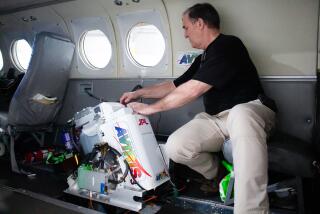A Visit to a Distant Cousin
- Share via
There may well be industrious colonies of ants, moving earth one grain at a time, whose more adventurous members skitter to the edge of a front porch and look up. Sensing the vast open space of a lawn and streetlight pole beyond, they might speculate on the unporchly light and the enormity of the unknown universe out there.
So here earthlings sit on the verge of summer, following the stock market, SARS, playoff games and a 10-year Chinese earthmoving project called the Three Gorges Dam. In Colorado, a team of scientific adventurers, intrigued by a distant blur called Pluto, organize an unmanned mission to fly by that planet just to see what’s there, after seven decades of speculation. About 13 years from now, if the batteries and gear survive at minus-400 degrees in the permanent night of space, we may get an inkling.
Surely such romance and curiosity fueled early global explorers, who could drift on the sea winds for three or four years to unknown oceans.
It’s the same exploration spirit, captured by The Times’ Usha Lee McFarling in her reports on space research, that permeates studies of our own solar system even as most of us remain captured in the orbits of more mundane earthly events.
Last Sunday, five decades after two men first climbed the tallest mountain on Earth, European scientists launched a research vessel called Beagle 2, after the 19th century research vessel of the evolution theorist Charles Darwin. If it’s fit enough to survive, that craft will parachute to the surface of Mars this Christmas Day.
The Pluto project is scheduled for launch in 2006. Flying at 57 times the speed of sound, it should zip by the planet 10 years later. Pluto is the most distant and unexplored planet, up to nearly 4 billion miles away. Mainly a glob of frozen methane, it is barely two-thirds the size of Earth’s moon and lumbers through an immense orbit of the sun lasting more than two centuries. The 935-pound probe will begin its one-way trip from Cape Canaveral and head the wrong way, toward Jupiter, to get a gravitational slingshot swing for its decade-long drift and drive-by photos of a primordial blur encased in eternal frost.
Watching from down here will be scientists who have studied Pluto their entire careers, wondering what’s out there. So long is this lonesome journey, beyond all the light poles, that some of these scientists will retire to sit on front porches and gaze at that unearthly light before the trip pictures get developed.






